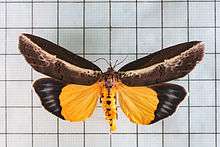Eligma narcissus
| Ailanthus Defoliator | |
|---|---|
 | |
| Scientific classification | |
| Kingdom: | Animalia |
| Phylum: | Arthropoda |
| Class: | Insecta |
| Order: | Lepidoptera |
| Family: | Nolidae |
| Genus: | Eligma |
| Species: | E. narcissus |
| Binomial name | |
| Eligma narcissus (Cramer, 1775)[1] | |
| Synonyms | |
| |
The Ailanthus Defoliator, (Eligma narcissus), is a moth in the Nolidae family. It is found in the Oriental tropics and subtropics of China, India, Sri Lanka, Java and Southeast Islands.
Description
Head and thorax greyish-brown and spotted in black. Abdomen bright yellow with dorsal and lateral series of black spots. Fore legs are grey-brown and spotted with black. Mid and hind legs are yellowish with black spots on tibia. Tarsi grey-brown in color. Fore wings are greyish-brown where costal area is with an olive tinge. There is an irregular and diffused curved white fascia from base to apex. Some basal and sub-basal black spots. A waved black line runs from lower angle of cell to inner margin. A submarginal series of black spots, those towards outer angle conjoined into streaks. Hind wings are bright yellow in color. Apical area is black, suffused or streaked with dark blue, and terminating at vein 1b. Cilia whitish at tips.[2]
Ecology
The larvae feed on Canarium and Ailanthus species, including Ailanthus fordii. Young larvae skeletonise leaflets, while older larvae are defoliators.[3][4] They are also found to feed on Ailanthus altissima, Amygdalus persica, and Toona sinensis from China.[5]
-
.jpg)
Ailanthus triphysa leaves with larva of Eligma narcissus moth
-

Larva hanging on silk from Ailanthus triphysa
References
- ↑ TaiBNET - Catalogue of Life of Taiwan
- ↑ Hampson G. F. (1892). "The Fauna Of British India Including Ceylon And Burma Moths Vol-ii". Digital Library of India. p. 558. Retrieved 4 July 2016.
- ↑ hkmoths.com
- ↑ "Eligma narcissus (Cramer)". ICAR-National Bureau of Agricultural Insect Resources. Retrieved 23 July 2016.
- ↑ "Comparative Mitochondrial Genome Analysis of Eligma narcissus and other Lepidopteran Insects Reveals Conserved Mitochondrial Genome Organization and Phylogenetic Relationships". National Center for Biotechnology Information. Retrieved 23 July 2016.
External links
- Biology of the Ailanthus Defoliator,Eligma narcissus (Cramer): Eligma narcissus (Lepidoptera: Noctuidae): A defoliator of Ailanthus spp
- Eligma narcissus Caterpillar
- On the copulation mechanism of Eligma narcissus